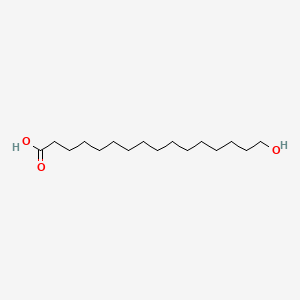
|
Juniperic acid |
Juniperic acid is a lipid of Fatty Acyls (FA) class. |
79 |
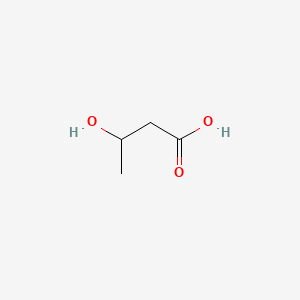
|
3-hydroxybutyric acid |
3-hydroxybutyric acid is a lipid of Fatty Acyls (FA) class. 3-hydroxybutyric acid is associated with abnormalities such as Ketosis. The involved functions are known as fatty acid oxidation, Oxidation, Synthesis, inhibitors and glucose metabolism. 3-hydroxybutyric acid often locates in Blood, Adipose tissue, Protoplasm, Hepatic and Extracellular. The associated genes with 3-hydroxybutyric acid are Genes, Developmental and Oncogene, RET. The related lipids are Fatty Acids, Nonesterified, 6-hydroxyhexanoate, tributyrin, 3-Hydroxyvalerate and Valerates. |
4735 |

|
(r)-3-hydroxybutanoic acid |
(r)-3-hydroxybutanoic acid is a lipid of Fatty Acyls (FA) class. |
2710 |
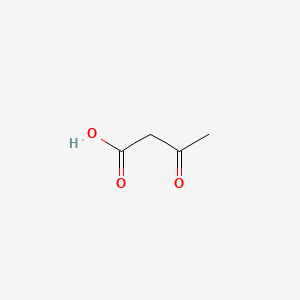
|
Acetoacetic acid |
Acetoacetic acid is a lipid of Fatty Acyls (FA) class.Acetoacetic acid is associated with abnormalities such as Dehydration. The involved functions are known as Biochemical Reaction, intracellular signal transduction, fatty acid elongation, Cytokinesis and Mass-to-Charge Ratio. The associated genes with Acetoacetic acid are CFB gene and mersacidin. Acetoacetic acidis associated with Carbon, Acids, Potassium, Acetoacetic acid and Oximes. The related lipids are Nonesterified Fatty Acids and Stearates. |
2523 |

|
Pyruvic acid |
Pyruvic acid is a lipid of Fatty Acyls (FA) class. |
27047 |
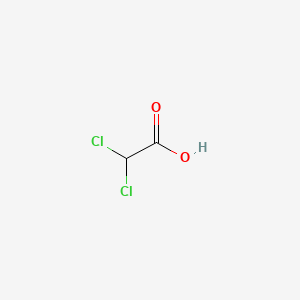
|
Dichloroacetic acid |
Dichloroacetic acid is a lipid of Fatty Acyls (FA) class. Dichloroacetic acid is associated with abnormalities such as Acidosis, Lactic, Metabolic Diseases, CLEFT LIP, CONGENITAL HEALED, Asthma and hyperthyroid. The involved functions are known as inhibitors, Chlorination, Metabolic Inhibition, Process and Sterility. Dichloroacetic acid often locates in Intestine - Large Intestine - Cecum (MMHCC), Mouse Liver, Back and Head. The associated genes with Dichloroacetic acid are GSTZ1 gene, PSMA5 gene and Maleylacetoacetate isomerase. The related lipids are Nonesterified Fatty Acids. |
2361 |

|
6-aminohexanoic acid |
6-aminohexanoic acid is a lipid of Fatty Acyls (FA) class. 6-aminohexanoic acid is associated with abnormalities such as Blood Clot, Myocardial Infarction, Cerebrovascular accident, Renal impairment and Scoliosis, unspecified. The involved functions are known as Fibrinolysis, Agent, Hemorrhage, plasminogen activation and inhibitors. 6-aminohexanoic acid often locates in Chest, Blood, Body tissue, peritoneal and Plasma membrane. The associated genes with 6-aminohexanoic acid are P4HTM gene, BSND gene, MTPN gene, NDUFS4 gene and Homologous Gene. The related lipids are Phosphatidylserines and Butyric Acid. |
3685 |

|
4-aminobutyric acid |
4-aminobutyric acid is a lipid of Fatty Acyls (FA) class. 4-aminobutyric acid is associated with abnormalities such as Epilepsy and Premenstrual syndrome. The involved functions are known as Binding (Molecular Function), neuron survival, Process, Uptake and physiological aspects. 4-aminobutyric acid often locates in Microglial, Neurofilament, Neuraxis, Brain region and Neurites. The associated genes with 4-aminobutyric acid are arginine methyl ester, SLC33A1 gene, NKS1 gene, P4HTM gene and ITSN2 gene. The related lipids are pregnenolone sulfate, pregnane-20-one, Pregnanes, Steroids and endogenous steroids. |
19702 |

|
L-norvaline |
L-norvaline is a lipid of Fatty Acyls (FA) class. L-norvaline is associated with abnormalities such as Celiac Disease, Exanthema, Atherosclerosis, Plasmodium falciparum infection and Parasitemia. The involved functions are known as Anabolism, Saturated, Stimulus, Physiologic Organization and arginase activity. L-norvaline often locates in Extracellular, Protoplasm, soluble, viral nucleocapsid location and Cell Wall. The associated genes with L-norvaline are norvaline, Amino Acids, Basic, ARG1 gene, Escherichia coli Proteins and Operon. The related lipids are Lipopolysaccharides. |
328 |

|
2,5-diaminopentanoic acid |
2,5-diaminopentanoic acid is a lipid of Fatty Acyls (FA) class. The involved functions are known as Vasodilation, Intestinal Absorption and Pinocytosis. 2,5-diaminopentanoic acid often locates in Mitochondria, Microfilaments, NADH dehydrogenase complex and respiratory chain complex III location sensu Eukarya. The associated genes with 2,5-diaminopentanoic acid are GAPDH gene and iberiotoxin. |
8868 |
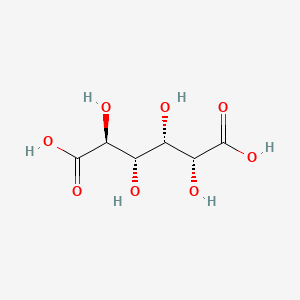
|
Glucaric acid |
Glucaric acid is a lipid of Fatty Acyls (FA) class. Glucaric acid is associated with abnormalities such as Consumption-archaic term for TB and furuncle. The involved functions are known as Oxidation, Mutation, Process, Cell Growth and Anabolism. Glucaric acid often locates in BL21, Clone and host. The associated genes with Glucaric acid are MIOX gene, ISYNA1 gene, Genome and Candidate Disease Gene. The related experimental models are Knock-out. |
1814 |

|
9-hydroxystearic acid |
9-hydroxystearic acid is a lipid of Fatty Acyls (FA) class. |
31 |
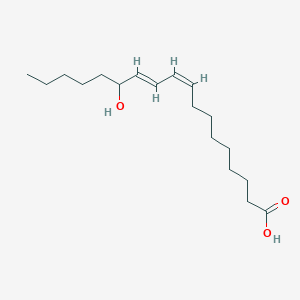
|
Coriolic acid |
Coriolic acid is a lipid of Fatty Acyls (FA) class. The involved functions are known as Autoimmunity, Autoimmune, T-cell differentiation, Binding (Molecular Function) and T-Cell Activation. The associated genes with Coriolic acid are IL2 gene. The related lipids are 9-hydroxy-10,12-octadecadienoic acid, hydroxy fatty acid and octadecadienoic acid. |
326 |
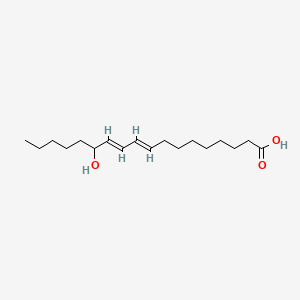
|
alpha-artemisic acid |
Alpha-artemisic acid is a lipid of Fatty Acyls (FA) class. |
448 |

|
29623-28-7 |
29623-28-7 is a lipid of Fatty Acyls (FA) class. |
324 |
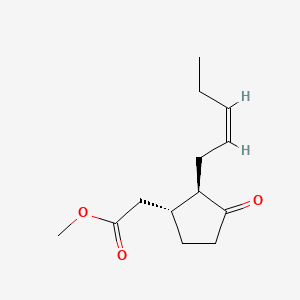
|
Methyl jasmonate |
Methyl jasmonate is a lipid of Fatty Acyls (FA) class. Methyl jasmonate is associated with abnormalities such as Infection, abnormal fragmented structure, Disintegration (morphologic abnormality), Parasitic Diseases and Contracture. The involved functions are known as Stimulus, Signal, Cell Death, Infiltration and Mutation. Methyl jasmonate often locates in Extracellular, Plasma membrane, Cytoplasm, Cell Wall and Body tissue. The associated genes with Methyl jasmonate are Polypeptides, Homologous Gene, NPR1 gene, systemin and Locus. The related lipids are Fatty Acids, Saponins and Oxylipins. |
2442 |

|
Prostaglandin E2 |
Prostaglandin E2 is a lipid of Fatty Acyls (FA) class. Prostaglandin e2 is associated with abnormalities such as Renal glomerular disease, Arthritis, Degenerative polyarthritis, Pancreatitis and Rheumatoid Arthritis. The involved functions are known as enzyme pathway, Atherogenesis, Anabolism, inhibitors and Oxidants. Prostaglandin e2 often locates in Tissue membrane, Blood, Extracellular, Membrane and Protoplasm. The associated genes with Prostaglandin E2 are PTGS2 gene, TP53 gene, TNFRSF5 gene, FASTK Gene and TNF gene. The related lipids are Lipopolysaccharides, Steroids, monooxyethylene trimethylolpropane tristearate, Fatty Acids, Unsaturated and Promega. The related experimental models are Arthritis, Adjuvant-Induced, Xenograft Model, Experimental Autoimmune Encephalomyelitis, Cancer Model and Knock-out. |
49278 |

|
PGD2 |
Pgd2 is a lipid of Fatty Acyls (FA) class. Pgd2 is associated with abnormalities such as Inflammatory disorder, Pleurisy, Rhinitis, Dehydration and Pneumonia. The involved functions are known as antagonists, fat cell differentiation, Phosphorylation, Process and Gene Expression. Pgd2 often locates in Cell surface, Body tissue, Extracellular, Bone Marrow and Membrane. The associated genes with PGD2 are oxytocin, 1-desamino-(O-Et-Tyr)(2)-, P4HTM gene, PTGS2 gene, PTGDS gene and IL3 gene. The related lipids are 15-deoxyprostaglandin J2, Nonesterified Fatty Acids, Lipopolysaccharides, Steroids and Liposomes. The related experimental models are Knock-out and Rodent Model. |
6464 |

|
11beta-PGF2 |
11beta-pgf2 is a lipid of Fatty Acyls (FA) class. |
15009 |

|
Leukotriene b4 |
Leukotriene b4 is a lipid of Fatty Acyls (FA) class. The involved functions are known as Chemotaxis, release of sequestered calcium ion into cytoplasm and Polymerization. Leukotriene b4 often locates in Protoplasm. The associated genes with Leukotriene b4 are phallacidin. |
9311 |



















